| |
| |
 |
|
| |
|
|
 |
January 2007
|
 |
| |
|
|
|
| |
In this issue:
1. Guest Spot: Top Ten List for Leaders
2. Lawson Design Studio, Part 2: How Does It Work and Where Does It Fit?
3. Worthwhile Reading
4. Lawson Tips & Tricks
The LawsonGuru Letter is a free periodic newsletter providing provocative commentary on issues important to the Lawson Software community. The LawsonGuru Letter is published by—and is solely the opinion of—John Henley of Decision Analytics.
Visit Decision Analytics at https://www.danalytics.com. For subscription information, see the bottom of this message. The LawsonGuru Letter is not affiliated with Lawson Software.
The start of a New Year is often a time of reflection, prospection and introspection. In that spirit, I'd like to introduce you to Bill Webb, who takes over the Guest Spot this month. Please visit Bill at The Blue Flame Project—his leadership development consulting organization—and sign up for his weekly Catch Fire newsletter. So, relax and enjoy the start of 2007. Let's make it a great year!
|
|
|
| |
|
|
|
| |
1. Guest Spot: Top Ten List for Leaders |
 |
|
| |
(by Bill Webb, The Blue Flame Project)
|
|
|
| |
We live in a world of sound bites and executive summaries. We are so busy we need our information in small, quick doses that we can easily digest between meetings or while waiting for the subway. We want it to be relevant, concise, and to the point.
With that in mind, I wanted this article to provide just that kind of a reminder of what we each can do to be effective leaders. Relevant, concise and to the point. No beating around the bush. No dancing around the edges. If you are doing a majority of these things each and every day, you are living your life as a leader.
1) Make expectations clear. How can you and your people know if they are doing their jobs if you have not made perfectly clear what is expected of them? Put it on paper, communicate, measure it, and reinforce it.
2) Don’t settle for good enough. In the trucking industry, we often try and justify that deliveries will be late, drivers will leave, and accidents will happen, etc., etc., etc. When we communicate the idea that we can’t expect to get it right every time then we certainly won’t. Set the bar high and your people are much more likely to reach it. Aim for the moon and your people will help you get there.
3) Catch people doing something right. It is easy to catch people doing something wrong. However, leadership involves getting out with your people and reinforcing what they are doing right. What we focus on, we get more of. Focus on what is going right and we have a better chance of seeing more if it.
4) Add value to every interaction you have. You have the opportunity to leave every situation better than you found it. It may take a little longer. It might even be a little uncomfortable at times. I challenge you to ask yourself if you made any given situation better or worse. If the answer is not better, go back and fix it.
5) Focus on what is right and not who is right. It is critical that we know the difference between focusing on the issue and focusing on the people involved in the issue. Sometimes we get the two confused. We often fail to address an issue because we get distracted by the people involved in the issue. Deal with what is right first and who is right second.
6) Lead people, manage systems and processes. We can’t manage our people because management is about control. People do not want to be controlled. We manage what goes on in our organizations – our systems and processes -- but we lead the people that make it happen. There is a subtle but critical difference. Manage things. Lead people.
7) Whatever you need more of, practice doing more of it. If you believe communication is lacking in your company, make the commitment to begin today to be a better communicator. If customer service is not what it needs to be, begin today to lead by example by providing the highest levels of customer service. Lead by example
8) Constantly reinforce the vision. People need a light at the end of the tunnel. They need to be able to identify the destination. People need something to believe in. When we simply tell our folks to get on the bike and start pedaling, you limit their effectiveness. Help them, through a clearly communicated vision of where the pedaling will get them. You owe it to yourself and your people.
9) Surround yourself with quality people. You simply cannot make a profit despite your people. Hire the absolute best people you can. They are an extension of you. It is those around you that will determine your effectiveness. And if you have a personnel problem, deal with it. Procrastination is the biggest enemy to leadership.
10) Finally, care of yourself. You won’t do anyone any good if you are unable to function effectively in your position. Take care of yourself physically and mentally and allow yourself the opportunity to recharge. People are looking to you in so many cases to decide how they should be. Set the ultimate example by taking care of yourself and you will help insure a healthier organization.
That’s it. Short, sweet and to the point. We have talked many times about the difference in managing and leading. If your daily life involves many or all of the suggestions listed above, make no mistake, you are leading.
We have plenty of managers in our world today. Make the choice to be a leader today and every day and change the world in a meaningful way! |
|
|
| |
|
|
|
| |
2. Lawson Design Studio, Part 2: How Does It Work and Where Does It Fit? |
 |
|
| |
|
|
|
| |
This month we continue our in-depth look at Lawson Design Studio. Last month (see https://www.danalytics.com/guru/letter/archive/2006-12.htm) , we looked at what Design Studio is—this month we’re going to look at how it works, and where it fits within the overall Lawson architecture.
How does it work?
When a Lawson program gets compiled, an .xml file it created, containing the “presentation” characteristics for the form:
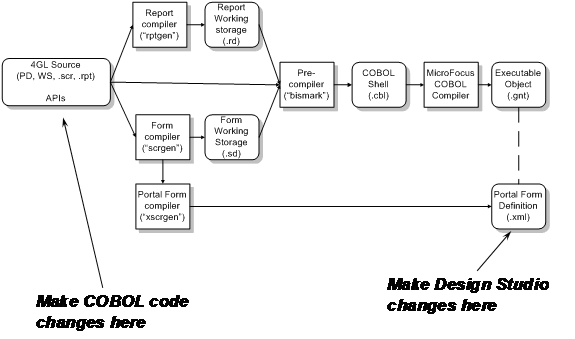
The role of Lawson Design Studio is to create derivatives of that .xml file, customizing them to your needs. Then, when you access a Lawson Portal form, one of the things that happens behind the scenes—assuming you’ve selected it as the ‘default presentation’ for the given form (don’t worry, we’ll get to that in a future article)—is that IOS loads the Design Studio customized version of the form:
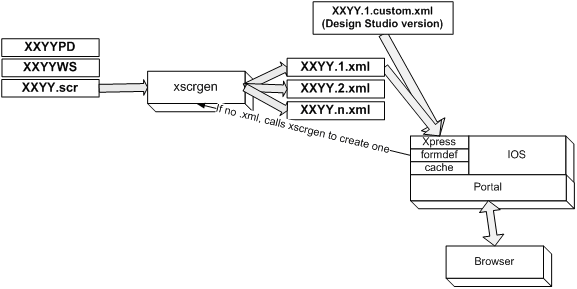
Where does it fit?
Before we can answer that question, we need to take a brief detour. Lawson has a flexible three-tier architecture, which allows separation of the “presentation tier” from “application tier” from the “database tier”:
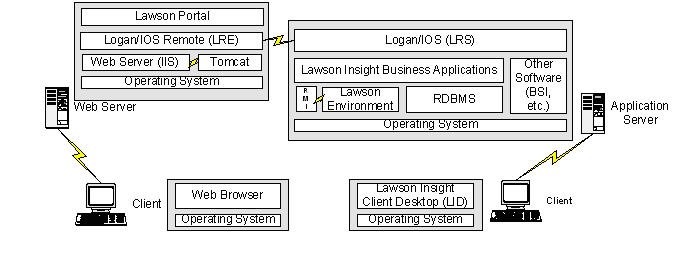
One of the benefits of this type of architecture is that Lawson can “swap out” parts at different levels of the architecture without (theoretically, at least) affecting the rest of their application stack. This is one of Lawson’s core strengths, and why they were able to quickly adapt their software for the internet (and therefore to be able to offer Lawson as browser-based applications). Sure, it wasn’t perfect, nor did it scale very well (i.e. this is what prompted the replacement of 7.x LOGAN CGI programs with 8.x IOS Java servlets), but the changes were only needed for certain layers of Lawson’s software. The application and the database layers were largely left unchanged.
One of the tiers in the stack—called the “presentation layer”—is the user interface for Lawson’s applications. We’ve seen a lot of them--be it character-mode LID, GUI LID, JED, NED, COM+, XML UI, Lawson Portal, etc. Regardless, you're still executing Lawson's "business logic" at the core. And, yes that core is written in COBOL (or RPG on the AS/400), and someday—if all works according to Lawson’s plans—it will be Landmark-generated Java.
So, there you have it—the presentation layer, and specifically, Lawson Portal—is where Lawson Design Studio fits in. Design Studio is the Lawson-delivered way to modify your Lawson Portal pages.
|
|
|
| |
|
|
|
| |
3. Worthwhile Reading |
 |
|
| |
|
|
|
| |
8 Expensive IT Blunders
- QUOTE OF THE ISSUE –
“You may delay, but time will not.”
-- Ben Franklin
Our hall of shame of tech failures includes McDonald's $170 million ERP fiasco, an electric-company software bug that wiped out power to much of the northeastern U.S. and Canada, and more. Get the sordid details and find out how you can avoid a disaster of your own.
Information Week, October 16, 2006
http://www.informationweek.com/news/showArticle.jhtml?articleID=193302693
The Art of Influence
Without it, you'll never get anything done. Four veteran CIOs share some tried-and-true techniques for convincing colleagues to do what's needed.
CIO Magazine, November 1, 2006
http://www.cio.com/archive/110106/fea_leadership.html
Climb Every Warehouse: Managing Data Warehouse Growth
Data warehouses are growing rapidly--and not just in sheer size. Conflicting demands to support more users, increased query and data complexity and more "right-time" information have organizations coming to a crossroads. Stakeholders need to know: Do we have the right architecture for growth? Can we scale up without breaking the bank? And do we have the personnel to manage this beast?
Intelligent Enterprise, November 2006
http://www.intelligententerprise.com/showArticle.jhtml?articleID=193105574
|
|
|
| |
|
|
|
| |
4. Lawson Tips & Tricks |
 |
|
| |
Share your Tips & Tricks. Send them to mailto:letter-tips@lawsonguru.com.
You can view other Tips & Tricks on the Tips & Tricks page on LawsonGuru.com.
Changing the Lawson Portal session timeout with LSF9
It’s one of the long-awaited features that arrives with LSF9—the ability to automatically timeout your Lawson Portal browser sessions (and before you ask—no, this doesn’t provide a timeout for LID sessions).
The default is set to 60 minutes, which is probably too long for some environments. Changing it is easy—Administrators can use LID to invoke the ssoconfig utility (do not change the SSOP service that used to sign on):
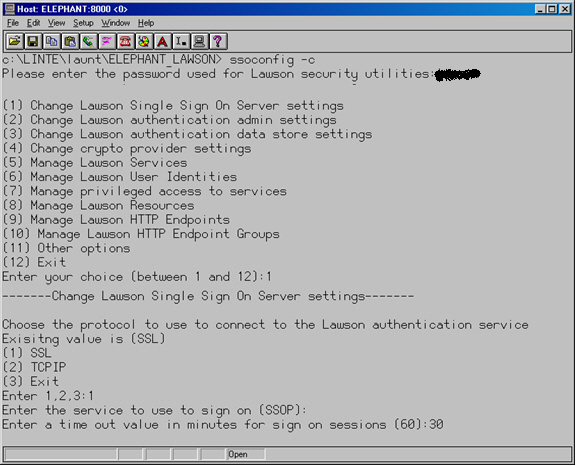
The timeout is used across all users—regardless of group or role, etc.—an enhancement which a number of clients have already requested.
Also, keep in mind, of course, that session timeout does not actually close the browser; nor does it hide the information that is on your screen when you walk away from your desk. For that, you still need to rely on your screensaver's “on resume, password protection”:
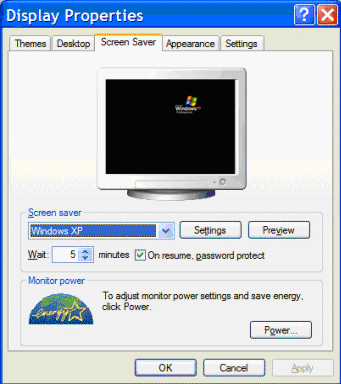
|
|
|
| |
|
|
|
| |
© Copyright 2007, Decision Analytics. All rights reserved. |
|
|
|
| Please share The LawsonGuru Letter in whole or in part as long as copyright and attribution are always included. |
| |
|
Decision Analytics is an independent consultancy, focusing on Lawson technical projects, and specializing in reporting, customization/modification, data conversion, and integration/interfaces. Please visit https://www.danalytics.com for more information.
|
|